Related Research Articles
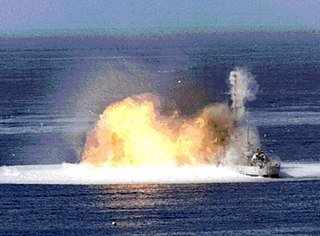
A thermobaric weapon, also called an aerosol bomb, or a vacuum bomb, is a type of explosive that uses oxygen from the surrounding air to generate a high-temperature explosion. The fuel–air explosive is one of the best-known types of thermobaric weapons.

A cluster munition is a form of air-dropped or ground-launched explosive weapon that releases or ejects smaller submunitions. Commonly, this is a cluster bomb that ejects explosive bomblets that are designed to kill personnel and destroy vehicles. Other cluster munitions are designed to destroy runways or electric power transmission lines, disperse chemical or biological weapons, or to scatter land mines. Some submunition-based weapons can disperse non-munitions, such as leaflets.
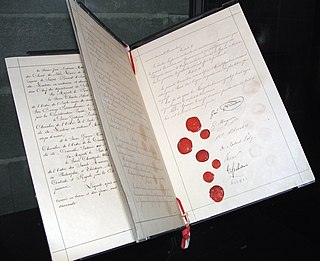
The law of war is the component of international law that regulates the conditions for initiating war and the conduct of warring parties. Laws of war define sovereignty and nationhood, states and territories, occupation, and other critical terms of law.
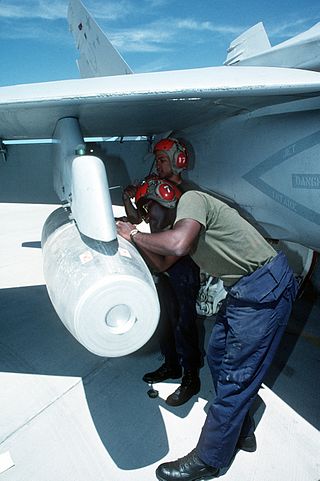
Incendiary weapons, incendiary devices, incendiary munitions, or incendiary bombs are weapons designed to start fires or destroy sensitive equipment using fire, using materials such as napalm, thermite, magnesium powder, chlorine trifluoride, or white phosphorus. Though colloquially often known as bombs, they are not explosives but in fact are designed to slow the process of chemical reactions and use ignition rather than detonation to start or maintain the reaction. Napalm, for example, is petroleum especially thickened with certain chemicals into a 'gel' to slow, but not stop, combustion, releasing energy over a longer time than an explosive device. In the case of napalm, the gel adheres to surfaces and resists suppression.
International humanitarian law (IHL), also referred to as the laws of armed conflict, is the law that regulates the conduct of war. It is a branch of international law that seeks to limit the effects of armed conflict by protecting persons who are not participating in hostilities and by restricting and regulating the means and methods of warfare available to combatants.

White phosphorus munitions are weapons that use one of the common allotropes of the chemical element phosphorus. White phosphorus is used in smoke, illumination, and incendiary munitions, and is commonly the burning element of tracer ammunition. Other common names for white phosphorus munitions include WP and the slang terms Willie Pete and Willie Peter, which are derived from William Peter, the World War II phonetic alphabet rendering of the letters WP. White phosphorus is pyrophoric ; burns fiercely; and can ignite cloth, fuel, ammunition, and other combustibles.

The United Nations Convention on Certain Conventional Weapons, concluded at Geneva on October 10, 1980, and entered into force in December 1983, seeks to prohibit or restrict the use of certain conventional weapons which are considered excessively injurious or whose effects are indiscriminate. The full title is Convention on Prohibitions or Restrictions on the Use of Certain Conventional Weapons Which May Be Deemed to Be Excessively Injurious or to Have Indiscriminate Effects. The convention covers land mines, booby traps, incendiary devices, blinding laser weapons and clearance of explosive remnants of war.
Fallujah, The Hidden Massacre is a documentary film by Sigfrido Ranucci and Maurizio Torrealta which first aired on Italy's RAI state television network on November 8, 2005. The film documents the use of chemical weapons, particularly the use of incendiary bombs containing white phosphorus, and alleges that insurgents and civilians, including children, had been killed or injured by chemical burns by military forces of the United States of America in the city of Fallujah in Iraq during the Fallujah Offensive of November 2004.
The Protocol on Blinding Laser Weapons, Protocol IV of the 1980 Convention on Certain Conventional Weapons, was issued by the United Nations on 13 October 1995. It came into force on 30 July 1998. As of the end of April 2018, the protocol had been agreed to by 109 nations.

War can heavily damage the environment, and warring countries often place operational requirements ahead of environmental concerns for the duration of the war. Some international law is designed to limit this environmental harm.

The Grozny ballistic missile attack was a wave of Russian ballistic missile strikes on the Chechen capital Grozny on October 21, 1999, early in the Second Chechen War. The attack killed at least 118 people according to initial reports, mostly civilians, or at least 137 immediate dead according to the HALO Trust count. Hundreds of people were also injured, many of whom later died.
Air warfare must comply with laws and customs of war, including international humanitarian law by protecting the victims of the conflict and refraining from attacks on protected persons.
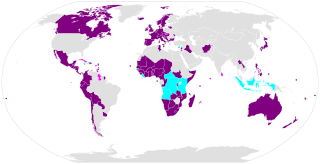
The Convention on Cluster Munitions (CCM) is an international treaty that prohibits all use, transfer, production, and stockpiling of cluster bombs, a type of explosive weapon which scatters submunitions ("bomblets") over an area. Additionally, the convention establishes a framework to support victim assistance, clearance of contaminated sites, risk reduction education, and stockpile destruction. The convention was adopted on 30 May 2008 in Dublin, and was opened for signature on 3 December 2008 in Oslo. It entered into force on 1 August 2010, six months after it was ratified by 30 states. As of April 2023, a total of 123 states are committed to the goal of the convention, with 111 states that have ratified it, and 12 states that have signed the convention but not yet ratified it.

An explosive weapon is a weapon that uses high explosive to project blast and/or fragmentation from a point of detonation.
The Protocol on Prohibitions or Restrictions on the Use of Mines, Booby-Traps and Other Devices is a United Nations treaty that restricts the use of land mines, remotely delivered mines, and booby traps. It is Protocol II to the 1980 Convention on Certain Conventional Weapons.
New physical principles weapons are a wide range of weapons or systems created using emerging technologies, like wave, psychophysical, and genetic weapons.
Convention on Certain Conventional Weapons – Group of Governmental Experts on Lethal Autonomous Weapons Systems refers to a group of experts created by the United Nations in order to study legal, ethical, societal and moral questions that arise from the increased use of autonomous robots to carry weapons and to be programmed to engage in combat in various situations that might arise, including battles between countries, or in patrolling border areas or sensitive areas, or other similar roles.
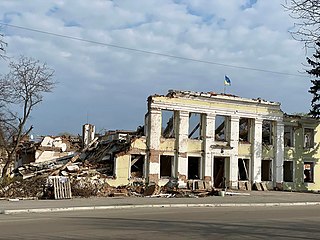
The battle of Okhtyrka was a military engagement in and around Okhtyrka city in Sumy Oblast of Ukraine. It began on 24 February 2022, as part of the Northeastern Ukraine offensive during the 2022 Russian invasion of Ukraine. Fighting began in the outskirts of the city as Russian forces attempted to occupy the city. The initial advance was repelled, and the city was attacked by artillery fire. On March 26, 2022, it was reported that the strategic stronghold of Trostianets was taken back by Ukrainian Forces. This disrupted Russian communications and supply routes, threatening the Russian front.
In international humanitarian law and international criminal law, an indiscriminate attack is a military attack that fails to distinguish between military objectives and protected (civilian) objects. Indiscriminate attacks strike both military and protected objects alike, thus violating the principle of distinction between combatants and civilians. They differ from direct attacks against civilians and encompass cases in which the perpetrators are indifferent as to the nature of the target, cases in which the perpetrators use tactics or weapons that are inherently indiscriminate, and cases in which the attack is disproportionate, because it is likely to cause excessive civilian casualties and damages to protected objects.
References
- 1 2 "Convention On Prohibitions Or Restrictions On The Use Of Certain Conventional Weapons Which May Be Deemed To Be Excessively Injurious Or To Have Indiscriminate Effects (With Protocols I, II And III)" (PDF). United Nations, Treaty Series , vol. 1342. p. 137. Retrieved 14 January 2023.
- ↑ "Protocol on Prohibitions or Restrictions on the Use of Incendiary Weapons (Protocol III). Geneva, 10 October 1980". International Committee of the Red Cross. Retrieved 14 January 2023.
- ↑ D. Schindler and J. Toman, The Laws of Armed Conflicts, Martinus Nijhoff Publishers, 1988, pp.190-191.
- ↑ "Ukraine's ambassador to US says Russia used a vacuum bomb, international groups say banned cluster munitions used to strike shelter". Australian Broadcasting Corporation. 1 March 2022. Retrieved 4 March 2022.
- 1 2 Hanson, Marianne (2 March 2022). "What are thermobaric weapons? And why should they be banned?". The Conversation. Retrieved 2 November 2022.
- ↑ Dunlap, Charlie (27 February 2022). "The Ukraine crisis and the international law of armed conflict (LOAC): some Q & A". Lawfire. Retrieved 4 March 2022.
- ↑ Seidel, Jamie (27 February 2022). "Father of all bombs': Russia's brutal weapon". news.com.au. Retrieved 11 March 2022.
- ↑ "1980 Convention on Certain Conventional Weapons – Factsheet". International Committee of the Red Cross. March 2014. Retrieved 4 January 2015.
- ↑ "Rule 84. The Protection of Civilians and Civilian Objects from the Effects of Incendiary Weapons". International Committee of the Red Cross. Retrieved 11 January 2015.
- ↑ "Protocol III to the Convention on Prohibitions or Restrictions on the Use of Certain Conventional Weapons which may be deemed to be Excessively Injurious or to have Indiscriminate Effects: Text of the Protocol". UNODA. Retrieved 23 June 2016.
- ↑ ICRC Database, Customary IHL , Practice, https://ihl-databases.icrc.org/en/customary-ihl/v2
- 1 2 "Practice relating to Rule 84. The Protection of Civilians and Civilian Objects from the Effects of Incendiary Weapons". International Committee of the Red Cross. Retrieved 14 January 2023.
- ↑ Pavel Felgenhauer, “Endorsing War Crimes”, Moscow Times, 12 July 2001, p. 6